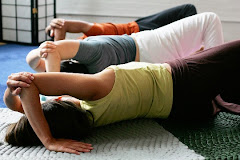One of the main themes of this blog will be the development of the reputation of the Feldenkrais Method via word-of-mouth, the most effective and least costly form of advertising.
As Feldenkrais practitioners, we think our problem is "talking about the Method." Actually, the problem lies in WHO is talking about the Method. So far, it's mostly just us, talking to each other. We need OTHER PEOPLE to be talking about the Feldenkrais Method. We need our students to share, with their friends:
- how much they enjoyed the experience of their most recent Feldenkrais lesson or class
- what changes they notice, moving, thinking, feeling, sensing, because of our influence
- that they are looking forward to their next class or lesson
- that they recommend us as a solution for their friends' movement difficulties.
Your best students will be your best source of referrals and testimonials, but you have to sort of "prime the pump" and get them thinking along those lines. Be prepared to capture those conversations. Here are some suggestions, in no particular order:
- allow for a few minutes at the end of each class to gather the group and ask them: "What did you notice? What changes did you experience?" Let each person talk, if they would like to. Close your mouth and LISTEN. Thank each person for sharing. Do this regularly, so they get practice in talking about their experiences in your class. They'll get better at it, via successive approximations! If anyone said something particularly wonderful, email them after the class and ask their permission to use what they said as a recommendation. Remind them what they said in class, and ask them to summarize it and send it to you in an email. I've found that people love to be acknowledged in this way. They know you listened to them and valued what they had to say. PRICELESS.
- follow-up with newcomers via phone or email, and ask what effects they felt from the lesson. Listen, ask permission to share. Follow up occasionally with each of your students, ask them what they notice is changing.
- be on the lookout on other websites for comments about the Feldenkrais Method. I am active on the microblog Twitter, and receive "Twilerts" for keywords I am interested in. Then, I'm notified via email whenever someone is "tweeting" about Feldenkrais, the Feldenkrais Method, movement, and others. I then begin to follow those people. They are then linked to another person who shares an interest with them, and the conversation continues.
- after you've established a relationship with your clients/classes, occasionally take an audio recorder or video camera to class. Do a fun, impromptu "man-on-the-street" (or floor) interview. You'll get a lot of silliness, but you'll also get some gems. (Note: if you're going to post audios, videos, or photos of your clients on your website, it's wise to have them sign a "model release form." Sample forms you can use are available online for free. Google to find them and modify for your situation.)
- invite people to email you after class if they have a particular thought or notice something interesting after class. Sometimes, people will email you spontaneously. Keep a file of these, you'll be able to use them!








First of all, thank you MaryBeth for this wonderfully clear, thoughtful and professional site! Along the lines of your advice to 'talk less and listen more', I have recently changed my website and brochure to have much less text, and more testimonials from students. Their comments not only resonate more with non-feldes, but are also 'free' advertising. Also, something I always do in my 2 weekly ATM classes is give out handouts. People love handouts! One is always the lesson of the day that I've re-typed from the source and lists the basic steps of the ATM. The other is an article or excerpt that I think my students will find interesting. For ex, this week, the HO is the AARP article about chronic pain that mentions Feldenkrais. Last week it was an article called "It's Never Too Late To Grow Your Brain", from the 12/08 edition of Brain in the News. (You can subscribe to this for free from the Dana Foundation.)
ReplyDeleteThanks for the "heads up" about the Dana Foundation. Their website is http://www.dana.org . There's a wealth of articles on this site!
ReplyDeleteWatch in the next InTouch for a piece about using articles and handouts to build relationships with clients. You're right on track!